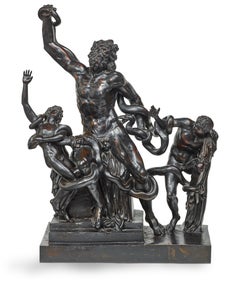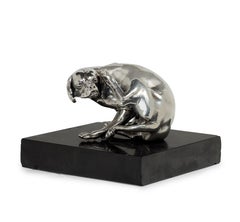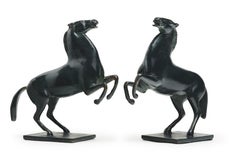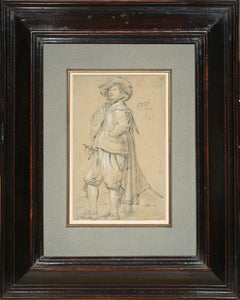Want more images or videos?
Request additional images or videos from the seller
1 of 7
Hercules carrying the World, a sculpture after Annibale Carracci's frescoCirca 1700
Circa 1700
$57,500List Price
About the Item
- Creation Year:Circa 1700
- Dimensions:Height: 9.82 in (24.95 cm)Width: 16.13 in (40.98 cm)Depth: 2.75 in (6.99 cm)
- Medium:
- Movement & Style:
- After:Annibale Carracci (1560 - 1609, Italian)
- Period:Late 17th Century
- Condition:Dimensions: 9 13/16 ‘’x 16 1/8’’ (25 x 41 cm) - maximum depth: 2 ¾’’ (7 cm) Gilded wooden frame with antique elements in the Louis XIV style (18 1/8’’ x 24 3/16’’ - 46 x 61.5 cm) Provenance: Private collection, Ile-de-France (France).
- Gallery Location:PARIS, FR
- Reference Number:1stDibs: LU1568211592042
About the Seller
5.0
Vetted Professional Seller
Every seller passes strict standards for authenticity and reliability
Established in 2020
1stDibs seller since 2021
10 sales on 1stDibs
Authenticity Guarantee
In the unlikely event there’s an issue with an item’s authenticity, contact us within 1 year for a full refund. DetailsMoney-Back Guarantee
If your item is not as described, is damaged in transit, or does not arrive, contact us within 7 days for a full refund. Details24-Hour Cancellation
You have a 24-hour grace period in which to reconsider your purchase, with no questions asked.Vetted Professional Sellers
Our world-class sellers must adhere to strict standards for service and quality, maintaining the integrity of our listings.Price-Match Guarantee
If you find that a seller listed the same item for a lower price elsewhere, we’ll match it.Trusted Global Delivery
Our best-in-class carrier network provides specialized shipping options worldwide, including custom delivery.You May Also Like
Vanitas Vanitatum
Located in Villafranca Di Verona, IT
Numbered and limited to 8 copies
Signature: Hand-signed by artist
Authenticity: Sold with certificate of Authenticity from the gallery
Invoice from the gallery
Sculpture: bronze, me...
Category
Early 2000s Old Masters Figurative Sculptures
Materials
Metal, Bronze
Erotic Sexual Mythological Marble Figural, Nude woman, Bacchante and Satyr Herm
Located in Miami, FL
Bacchic revelry. A sexy and nude curvaceous young Nymph/Bacchante makes amorous advances to a Herm - whose facial expression reflects her erotic touch. The Herm is stylized where his...
Category
Mid-19th Century Old Masters Nude Sculptures
Materials
Marble
$21,750 Sale Price
25% Off
H 54.5 in W 24 in D 13.5 in
Nude Male Runner Bronze patinated Classical After the Antique
Located in Miami, FL
Beautifully proportioned and handsome nude male bronze with Roman classically refined features after the Antique . It looks best with a key lighting th...
Category
20th Century Old Masters Nude Sculptures
Materials
Bronze
$38,000
H 50 in W 46 in D 19.5 in
Pair of 19th century scagliola sculptures (Italian Neoclassicism) - Roman figure
Located in Varmo, IT
Pair of scagliola sculptures - Roman figures. Italian manufacture, 19th century.
51 x 26 x h 118 cm (left) - 41 x 28 x h 118 cm (right).
Made entirely of scagliola. Depicting two f...
Category
Early 19th Century Old Masters Figurative Sculptures
Materials
Plaster
$5,776 Sale Price
20% Off
H 46.46 in W 20.08 in D 10.24 in
The sun Nili Pincas Contemporary art sculpture terracotta pastel woman dream
Located in Paris, FR
Unique terracotta sculpture
Signed by the artist
The contemplative creatures of Nili Pincas, of an extreme refinement, invite silence.
This isolation of the sculpted being seizes an...
Category
2010s Contemporary Figurative Sculptures
Materials
Terracotta
$5,896
H 20.48 in W 14.18 in D 5.52 in
Daphnis Nili Pincas Contemporary art sculpture terracotta pastel woman mythology
Located in Paris, FR
Unique terracotta sculpture
Signed by the artist
The contemplative creatures of Nili Pincas, of an extreme refinement, invite silence.
This isolation of the sculpted being seizes and soothes, at the same time as it questions.
Are we facing the face of anguish or introspection? The white or purple flesh, with a slightly grainy matte appearance, reveals the infinite sensuality of the artist’s touch...
Category
2010s Contemporary Figurative Sculptures
Materials
Terracotta
$5,415
H 24.81 in W 8.27 in D 8.67 in
Great menina dancer Nili Pincas Contemporary art sculpture terracotta pastel
Located in Paris, FR
Unique terracotta sculpture
Signed by the artist
The contemplative creatures of Nili Pincas, of an extreme refinement, invite silence.
This isolation of the sculpted being seizes and soothes, at the same time as it questions.
Are we facing the face of anguish or introspection? The white or purple flesh, with a slightly grainy matte appearance, reveals the infinite sensuality of the artist’s touch...
Category
2010s Contemporary Figurative Sculptures
Materials
Terracotta
$7,099
H 28.75 in W 16.93 in D 9.45 in
The tribe Nili Pincas Contemporary art sculpture terracotta pastel colour totem
Located in Paris, FR
Unique terracotta sculpture
Signed by the artist
The contemplative creatures of Nili Pincas, of an extreme refinement, invite silence.
This isolation of the sculpted being seizes and soothes, at the same time as it questions.
Are we facing the face of anguish or introspection? The white or purple flesh, with a slightly grainy matte appearance, reveals the infinite sensuality of the artist’s touch...
Category
2010s Contemporary Figurative Sculptures
Materials
Terracotta
$5,896
H 16.93 in W 15.75 in D 15.75 in
Big fish Nili Pincas Contemporary art sculpture terracotta pastel naive Jonas
Located in Paris, FR
Unique terracotta sculpture
Hand-signed by the artist
Nili PINCAS was born in 1942 in Tel Aviv, in Israel.
She studied at the Avni Art Institute of Tel Aviv in Israël and at the Eco...
Category
Early 2000s Contemporary Figurative Sculptures
Materials
Terracotta
$5,896
H 17.72 in W 9.45 in D 16.93 in
Woman on all fours Nili Pincas Contemporary art sculpture terracotta pastel
Located in Paris, FR
Unique terracotta sculpture
Signed by the artist
The contemplative creatures of Nili Pincas, of an extreme refinement, invite silence.
This isolation of the sculpted being seizes an...
Category
2010s Contemporary Figurative Sculptures
Materials
Terracotta
$5,896
H 14.97 in W 7.88 in D 11.42 in
More From This Seller
View AllLaocoön and his Sons, an exceptional bronze sculpture by Giacomo Zoffoli
Located in PARIS, FR
This exceptional bronze group (unpublished), executed in Rome in the second half of the 18th century, bears witness to the fascination with the Laocoön since its discovery on January...
Category
1770s Italian School Nude Sculptures
Materials
Bronze
Dog scratching its ear
Located in PARIS, FR
This amusing naturalistic sculpture in silver-plated pewter was probably made in the 17th century by Georg Schweigger. Inspired by a model created by another Nuremberg sculptor, Peter Flötner, it bears witness to the persistence during the baroque era of the naturalistic taste that emerged in the Renaissance. Intended as an ornament for some Kunstkammer, or cabinet of curiosities, this sculpture was a great success, as can be seen from the presence of similar works in many European museums.
1. Georg Schweigger
Georg Schweigger was a baroque sculptor and medal founder from Nuremberg, known mainly for his small-scale works in stone, carved wood and cast metal. His only large-scale work, the Neptune Fountain, has been in the Petershof Palace, the summer residence of the Tsars near St. Petersburg, since 1797. This monumental sculpture demonstrates his taste for the representation of movement, which we find in this small piece, inspired, as we shall see, by earlier models.
2. The success of a naturalistic theme
As is often the case in the history of art, the source of the Dog scratching his ear theme probably comes from an engraving, and more precisely from one made in Strasbourg in 1480 or in Aschaffenburg in 1481 by the Master of the Housebook, an anonymous engraver working in southern Germany at the end of the 15th century.
This engraving seems to have been Peter Flötner’s (1490 - 1546) source of inspiration. Peter Flötner was a sculptor and engraver who settled in Nuremberg in 1522. The Louvre Museum also has a gilded lead statuette dated between 1500 and 1515 (on deposit at the Musée de L'Œuvre in Strasbourg), which in turn is thought to have served as a model for other known statuettes.
This model was later taken up by the Frenchman Barthélemy Prieur...
Category
17th Century Naturalistic Figurative Sculptures
Materials
Marble, Silver
$6,437
Pair of Prancing Horses, two bronzes signed and numbered by Arno Breker
Located in PARIS, FR
An official artist of the Nazi regime, trained in Montparnasse in the 1930s, Arno Breker continued to sculpt after the fall of the Third Reich, producing large-scale public commissions in Germany and portraits of prominent figures. The two small bronzes presented here, dated around 1978, are part of a long tradition of prancing horses dating back to antiquity. The asymmetrical treatment of the two front legs and the inclination of the head make these two copies of the same artwork a highly decorative pair.
1. Arno Breker, a prolific sculptor, from the Bohemia of Montparnasse to the commissions from the Third Reich ... and from the Federal Republic of Germany
The son of a stone carver, Arno Breker studied fine art and anatomy in his native Elberfeld. At the age of 20, he entered the Düsseldorf Academy of Art. He moved to Paris in 1926, where he continued his training in the studio of Maillol, who dubbed him "the German Michelangelo of the twentieth century". He shared a studio with Alexandre Calder and frequented Jean Cocteau, Foujita, Brancusi, Pablo Picasso and other artists of the bohemian Paris of the time. It was also in Paris in 1933 that he met Demetra Messala, the daughter of a Greek diplomat who posed for Maillol and Picasso, whom he married in 1937. Having won the Prussian Prix de Rome in 1932, he left Paris to stay at the Villa Massimo, the German Academy in Rome.
Returning to Germany in 1934, his style evolved towards a more marked imitation of ancient sculpture. He created two monumental statues for Berlin's Olympic Stadium, before being appointed professor at the Berlin College of Fine Arts in 1937. He came to the attention of the Reich Propaganda Ministry, which awarded him several commissions and provided him with three large studios in which Breker produced many monumental sculptures to the glory of the regime. On June 23, 1940, Breker accompanied Adolf Hitler during a visit to Paris. During the Occupation, his political connections enabled him to intervene on behalf of many artists pursued by the Nazis: for example, he protected Pablo Picasso (then a Communist) from Kommandantur officers.
Most of Arno Breker's work was destroyed in Berlin at the end of the war in 1945 by bombing and intentional destruction perpetrated by soldiers of the victorious powers. After the fall of the Nazi regime, however, Arno Breker was never prosecuted. He opened a new studio in Düsseldorf, where he sculpted until his death in 1991.
He then carried out several public commissions in Germany (Bayreuth, Wuppertal), as well as portraits of numerous personalities, including King Mohammed V of Morocco, Léopold Sedar Senghor (commissioned by the Académie Française in 1978) and the two chancellors of the Federal Republic of Germany, Konrad Adenauer and Ludwig Erhard. The Arno Breker Museum in Nörvenich is now exhibiting some of his artworks.
2. Related artworks: from the Wild Horses of the Quirinal to the Horses of Marly
The prancing horse is a major iconographic theme, found in a series of sculptures from Antiquity, the Renaissance and the Classical Age. Various photos from Arno Breker's studio in Berlin confirm the predominant place of equine representations in his work (alongside male nude statues), and confirm that this reduced version created in 1978 is part of the artist's preferred repertoire.
Prancing horses are generally associated with a male figure in a group that, through a reference drawn from Antiquity, symbolizes man's domination over nature. In this respect, it is very interesting to compare our small bronzes with the horse forming part of a large sculpture by Arno Breker (made in 1936 and probably destroyed in 1945) depicting Alexander taming Bucephalus.
This statue is itself directly inspired by one of the best-known works of 18th-century French sculpture...
Category
1970s Art Deco Figurative Sculptures
Materials
Bronze
Young Man with a Sword, a Fist on his Hip, a drawing by Cornelis Saftleven
Located in PARIS, FR
Black chalk and white highlights on paper (originally washed in blue)
Monogrammed and dated 1630 on the right
This drawing, executed in black chalk and enhanced with white brushwor...
Category
1630s Old Masters Portrait Drawings and Watercolors
Materials
Paper, Chalk
Study in the Antique Style, a neoclassical drawing by Augustin Pajou
Located in PARIS, FR
In this lively and fresh drawing, probably taken from one of the artist's notebooks, Pajou presents us with a composition freely inspired by antiquity, as a souvenir of a visit to th...
Category
1750s Old Masters Figurative Drawings and Watercolors
Materials
Ink
Study for a Frontispiece, a baroque drawing by Giovanni Antonio Pellegrini
By Giovanni Antonio Pellegrini
Located in PARIS, FR
This masterly frontispiece study, executed with a very sure hand, testifies to the survival of the great Baroque taste in 18th century Venice. It could be one of the very last works by Giovanni Antonio Pellegrini: the few lines that cross the papal arms evoke those of Benedict XIV, who became pope in 1740, one year before the artist's death.
1. Giovanni Antonio Pellegrini and the European influence of Venetian history painting in the 18th century
Giovanni Antonio Pellegrini was born in Venice in 1675 and trained in the studio of the Milanese painter Paolo Pagani (1655 - 1716). Pagani, who had been living in Venice since 1667, took him to Moravia and Vienna from 1690 to 1696. After a stay in Rome from 1699 to 1701, Pellegrini married Angiola Carriera in 1704, the sister of the great pastelist Rosalba Carriera.
From 1708 onwards, Pellegrini left Venice and began an extensive tour of Europe: he worked in England between 1708 and 1713, where he met great success, particularly at Kimbolton Castle and Castle Howard. He then worked in Germany and the Netherlands, then in Bohemia and Austria, before returning briefly to England in 1719. In 1720 he was in Paris where he decorated the ceilings of the Royal Bank for John Law...
Category
1740s Old Masters Figurative Drawings and Watercolors
Materials
Ink
Recently Viewed
View AllMore Ways To Browse
High Relief Sculpture
Armillary Antique
17th Century Terracotta
Antique Armillary Sphere
Roman Clay
Antique Old World Art
Atlas Titan
Engraving Of Hercules
Rodin Iris
African Water Jugs
Marie Paule Deville
Joseph Holmes
Male Marble Nude Wrestling
Michael Naranjo
Sonia Pacheco
Mao Tse Tung
Maurice Barraud
Michael Gates



